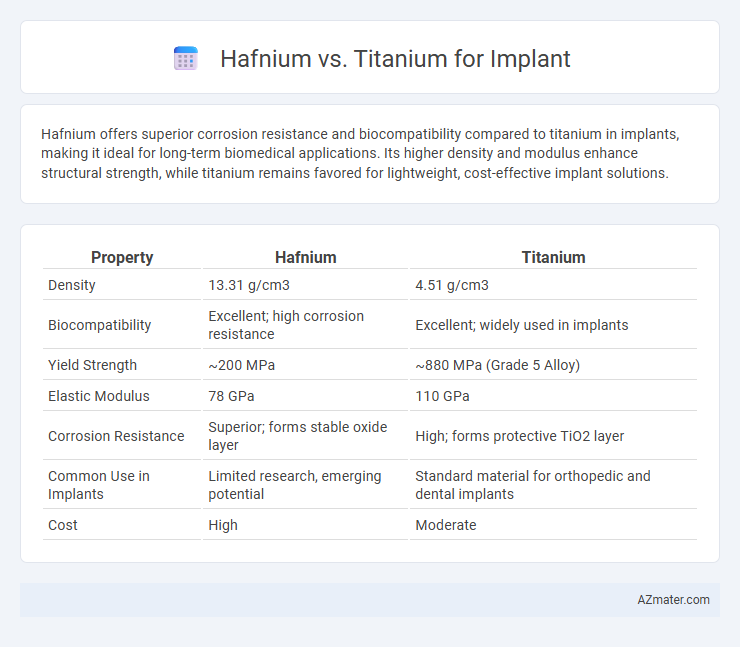Hafnium offers superior corrosion resistance and biocompatibility compared to titanium in implants, making it ideal for long-term biomedical applications. Its higher density and modulus enhance structural strength, while titanium remains favored for lightweight, cost-effective implant solutions.
Table of Comparison
| Property | Hafnium | Titanium |
|---|---|---|
| Density | 13.31 g/cm3 | 4.51 g/cm3 |
| Biocompatibility | Excellent; high corrosion resistance | Excellent; widely used in implants |
| Yield Strength | ~200 MPa | ~880 MPa (Grade 5 Alloy) |
| Elastic Modulus | 78 GPa | 110 GPa |
| Corrosion Resistance | Superior; forms stable oxide layer | High; forms protective TiO2 layer |
| Common Use in Implants | Limited research, emerging potential | Standard material for orthopedic and dental implants |
| Cost | High | Moderate |
Introduction to Hafnium and Titanium in Implants
Hafnium and titanium are critical materials used in the manufacturing of biomedical implants due to their exceptional biocompatibility and mechanical strength. Hafnium exhibits superior corrosion resistance and a higher density, which can enhance implant durability in harsh physiological environments, while titanium remains the standard for implants because of its lightweight properties and proven osseointegration capabilities. Both metals form stable oxide layers that prevent ion release, making them ideal for long-term implantation in the human body.
Chemical and Physical Properties Comparison
Hafnium and titanium exhibit distinct chemical and physical properties impacting their suitability for implants; titanium's excellent corrosion resistance and biocompatibility stem from its stable oxide layer, while hafnium offers superior density and neutron absorption but less extensive biological data. Titanium's low density (4.5 g/cm3) and high tensile strength make it ideal for lightweight, durable implants, whereas hafnium's higher density (13.3 g/cm3) may result in heavier implants with potential advantages in radiopacity for medical imaging. Both metals form protective oxide layers, but titanium's well-studied interactions with human tissue provide a clinical preference in orthopedic and dental applications.
Biocompatibility: Hafnium vs Titanium
Hafnium and titanium both exhibit excellent biocompatibility, but titanium remains the gold standard for implants due to its proven integration with bone and minimal allergic reactions. Hafnium, while less studied, shows promising corrosion resistance and cytocompatibility, making it a potential alternative in medical applications. Studies indicate hafnium's oxide layer enhances its biocompatibility, potentially surpassing titanium in long-term stability within the human body.
Corrosion Resistance in Biomedical Environments
Hafnium exhibits superior corrosion resistance compared to titanium in biomedical environments due to its stable oxide layer, which effectively prevents metal ion release and ensures long-term biocompatibility. Titanium, while widely used for implants, is more susceptible to localized corrosion in aggressive physiological conditions, potentially compromising implant integrity. The enhanced corrosion resistance of hafnium alloys makes them promising candidates for durable, high-performance biomedical implants.
Mechanical Strength and Longevity
Hafnium-enhanced titanium implants exhibit superior mechanical strength due to hafnium's ability to improve alloy hardness and fatigue resistance without compromising biocompatibility. Titanium remains the standard for implants because of its excellent strength-to-weight ratio, corrosion resistance, and proven longevity in biomedical applications. Incorporating hafnium into titanium alloys extends implant lifespan by enhancing wear resistance and reducing the risk of long-term mechanical failure under cyclic loading conditions.
Osseointegration Efficiency
Hafnium exhibits superior osseointegration efficiency compared to titanium due to its enhanced biocompatibility and corrosion resistance, promoting stronger bone-implant integration. The higher density and mechanical strength of hafnium alloys contribute to improved load distribution and stability in implant applications. Research indicates hafnium's surface oxide layer supports more rapid and robust bone cell attachment and proliferation than titanium, making it a promising material for long-term implant success.
Allergic Reactions and Toxicity
Hafnium exhibits superior biocompatibility compared to titanium, with significantly lower incidences of allergic reactions due to its inert surface properties and minimal ion release in the body. Titanium, while widely used in implants, can provoke hypersensitivity responses in sensitive individuals, primarily from the release of titanium ions and corrosion products. Toxicity levels are minimal for both metals, but hafnium's enhanced corrosion resistance and biostability reduce the risk of adverse biological interactions, making it a promising alternative for patients prone to metal allergies.
Cost and Availability for Medical Use
Hafnium implants are significantly more expensive than titanium due to the metal's rarity and complex extraction process, making titanium the preferred choice for cost-conscious medical applications. Titanium's widespread availability and established supply chain ensure consistent quality and lower pricing for implant manufacturing. Hospitals and medical device companies favor titanium for its affordability and reliable sourcing in producing orthopedic and dental implants.
Clinical Uses and Applications
Hafnium and titanium are both biocompatible metals used in medical implants, with titanium widely recognized for its exceptional strength, corrosion resistance, and osteointegration, making it the preferred choice for orthopedic, dental, and craniofacial implants. Hafnium, often alloyed with titanium, enhances mechanical properties and radiopacity without compromising biocompatibility, offering potential advantages in applications requiring improved wear resistance and imaging visibility. Clinical use of hafnium-titanium alloys remains limited but shows promise in enhancing implant longevity and performance in demanding load-bearing environments.
Future Prospects in Implant Technology
Hafnium shows promising future prospects in implant technology due to its exceptional biocompatibility, corrosion resistance, and ability to promote osseointegration, surpassing traditional titanium implants in durability. Research into hafnium alloys indicates enhanced mechanical strength and reduced inflammatory response, making them ideal for long-term implants in orthopedics and dental applications. Advances in nanostructuring and surface modification of hafnium implants are expected to further improve patient outcomes and implant longevity.

Infographic: Hafnium vs Titanium for Implant
 azmater.com
azmater.com